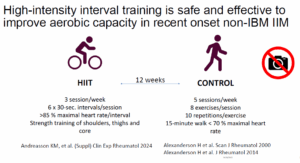CHICAGO—According to speakers in a presentation at ACR Convergence 2025, high-intensity interval training (HIIT) has been shown to be safe and have multiple health benefits—including improvements in cardiorespiratory fitness, immune function and disease activity—for those with inflammatory diseases. Speakers outlined these impacts and discussed how to best integrate HIIT into a person’s treatment plan.
“HIIT is realistic for most of our patients because intensity can be personalized to individual fitness levels,” said Kim Huffman, MD, PhD, professor of medicine at Duke University School of Medicine, Durham, N.C. “In patients with inflammatory arthritis, this intervention not only shows excellent improvement in cardiorespiratory fitness, but also inflammatory disease activity and self-reported outcomes such as fatigue.”
HIIT can take many forms. For example, Dr. Huffman recruited 12 older adults with rheumatoid arthritis (RA) for a pilot study. Over 10 weeks, they walked on a treadmill for 30 minutes, three times a week. Participants performed up to 90 seconds of high intensity exercise on the treadmill followed by a similar amount of time of active recovery at moderate to low intensity.1
Scores Improved
What surprised the researchers was improvement in disease activity scores. Those in high disease categories went to moderate, with other categories behaving similarly. Some even went into remission. They found the participants’ cardiorespiratory fitness (e.g., maximum oxygen consumption measured as peak VO2 in a cardiopulmonary exercise test) improved as well.
Dr. Huffman’s group showed that changes in systemic oxidative capacity from HIIT were highly associated with improvements in CD4+ T-cells oxidative capacity, and generated more naive CD4+ cells.
RA Not the Only Disease HIIT Effects
A combination of HIIT, aerobic training and resistance training resulted in lowered disease activity, increased fitness and positive changes in other areas in additional types of inflammatory arthritis, including psoriatic arthritis.2 Patients with psoriatic arthritis participated in three-times-weekly HIIT-based cycling with a control group that did not change its exercise regimen. There were no statistically significant between-group differences, but in the HIIT group, fatigue improved. In both groups, disease activity improved. Interestingly, the control group had better pain control.3
There is a dose-dependent relationship between cardiorespiratory fitness and all-cause mortality. There is also evidence that those with inflammatory diseases have greater risk for cardiovascular disease. HIIT addressed this concern as well.
In patients with inflammatory arthropathies at risk for cardiovascular events, HIIT led to health improvements. Compared to usual care controls, the group that participated in twice-weekly supervised and once-weekly unsupervised training saw improved fitness and disease activity within the HIIT group. However, there were no changes in cardiac metabolic risk factors.
These interventions have been linked to few adverse events. Dr. Huffman notes in one study, the only concern was one woman who complained of a sore ankle. This was remedied by changing shoes. Another participant was injured when they felt so much better they got on an ATV with their grandson and strained their back.
“HIIT allow our patients, especially those who have low levels of fitness, to start low, and more rapidly than would be attainable with traditional continuous moderate intensity training, get to a level where they can perform more challenging activities longer and with greater intensities,” said Dr. Huffman. “I like to call HIIT a gateway drug to long term physical activity behaviors and overall health improvements.”
HIIT as a Disease-Modifying Drug
Studies have found that multiple types of HIIT have positive outcomes for patients with myositis and systemic sclerosis as well. HIIT is more effective in improving aerobic capacity compared to home exercise and brisk walks. Helene Alexanderson, PhD, PT, an associate professor at Karolinska University Hospital in Stockholm, Sweden, called HIIT a kind of “disease modifying drug” that is underused.
“The take-home message is that patients with systemic inflammatory disease have reduced peak oxygen uptake and aerobic capacity, and there is strong dose-dependent association between fitness and lower all-cause mortality and cardiovascular disease,” said Dr. Alexanderson. “It is essential that we train aerobic capacity to optimize health.”
Proper supervision is essential when starting a HIIT regimen for a sense of safety and to maximize compliance. Patients should start at a low dose of exercise. Taking into account pain, fatigue, muscle function and goal, intensity can be ramped up over several weeks.
Recovery is important as well. Patients should understand it is necessary to take a day off. Alexanderson said that is when “all the really good metabolic things happen.”
“Also tell your patients that late onset muscle soreness is a good thing,” said Dr. Alexanderson. “It is a kind of receipt showing they did something beneficial for their muscles.”
HIIT & Flares
Both presenters said that in their experience they have seen very few flares, but when they do occur, the response should be made with the patient in consultation with their healthcare team. It may be something as easy as shifting exercise to later in the day. Medication adjustments might be needed.
Encourage maintenance of some general movement through the duration of the flare. Then, as the flare subsides, exercise can ramp back up as tolerated.
Look at HIIT as a medicine, and be specific when prescribing by noting the FITT variables of frequency, intensity, time and type. As treatment continues, evaluate and moderate intensive training for long-term outcomes.
“One caveat to keep in mind when deciding on HIIT for your patients is that long term benefits are unknown,” said Dr. Huffman. “Short-term benefits show its potential as an initial strategy to improve fitness, immune function and exercise self-efficacy.”
 Kurt Ullman is a freelance writer based in Indiana.
Kurt Ullman is a freelance writer based in Indiana.
References
- Bartlett DB, Willis LH, Slentz CA, et. al. Ten weeks of high-intensity interval walk training is associated with reduced disease activity and improved innate immune function in older adults with rheumatoid arthritis: A pilot. Arthritis Res Ther. 2018 June 14;20(1):127.
- Andonian BJ, Ross LM, Sudnick AM. Effect of remotely supervised weight loss and exercise training versus lifestyle counseling on cardiovascular risk and clinical outcomes in older adults with rheumatoid arthritis: A randomized controlled trial. ACR Open Rheumatol. 2024 Mar; 6(13):124–136.
- Thomsen RS, Nilsen TL, Haugeberg G, et al. Impact of high-intensity interval training on disease activity and disease in patients with psoriatic arthritis: A randomized controlled trial. Arthritis Care Res (Hoboken). 2019 April;71(4)530–537.
- Norden KR, Semb AG, Dagfinrud H, et. al. Effect of high-intensity interval training in physiotherapy primary care for patients with inflammatory arthritis: The ExeHeart randomized controlled trial. RMD Open. 2024 Jan 18;10(1);e003440.


